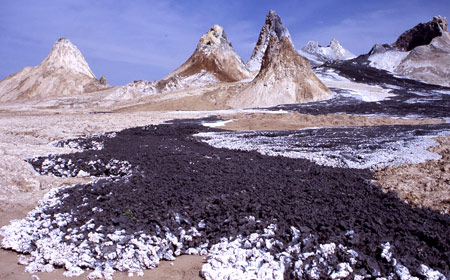
Africa is fracturing. Everything east of the Great Rift Valley--a 6000-kilometer gash that runs from Syria to Mozambique--is imperceptibly moving into the Indian Ocean. The valley itself is slowly sinking, and millions of years from now it will rest on the sea floor. Smack-dab in the middle of the valley sits Ol Doinyo Lengai, a classic volcanic cone rising nearly 3000 meters. But the mountain's eruptions are anything but classic. Its lava, called carbonatite, is nearly free of silicon oxide, which in sufficient quantity produces the blazing-hot, flame-red flows people typically associate with volcanoes. Instead, Ol Doinyo Lengai's carbonatite lava is much cooler--only about 500°C, compared with 1000°C or more for conventional eruptions. It also flows easily and rapidly, more like water than lava. Initially, the carbonatite is black but turns white quickly after exposure to rain and surface water.
Ol Doinyo Lengai's idiosyncrasies have puzzled scientists since the 1960s. So, volcanologist Tobias Fischer of the University of New Mexico, Albuquerque, and colleagues gave the volcano a more intense look. They focused on another peculiarity: The volcano contains numerous small fissures inside its cone that are venting gas coming directly from the mantle layer deep below the surface. Normally, volcanic vents are larger and quickly mix with the surface air. The team reports tomorrow in Nature that the gas they collected from these fissures contains carbon dioxide, helium, nitrogen, and argon--indistinguishable from volcanic gas released from vents in the sea floor. Essentially, the volcanology of the region is beginning to take on the characteristics of the processes at work at the bottom of the ocean, because that's where the Great Rift Valley is headed.
So, why is the mountain spewing out thin, runny, carbonatite lava? Fischer says it has to do with the thinness of Earth's crust beneath the volcano. "It's like a small [component] has separated from the nephelinite," a more silica-rich rock that originates in the mantle and generates conventional lava, he explains--like the oil that collects at the top of a jar of peanut butter. The carbonatite probably collects in small zones near the top of Earth's mantle, just below the crust. Wherever the crust is thin enough--on the ocean floor and the floor of the Great Rift Valley--the carbonatite can push through to the surface more easily, he explains. But it's a fleeting product, he says. For one thing, Ol Doinyo Lengai is too big a mountain to have been formed out of carbonatite, which is relatively soft and erodes quickly. For another, the team's analysis shows that the carbonatite eruptions are ending. "Right now, [the mountain is] switching back to nephelinite."
The research is solid, says geochemist Ken Sims of the Woods Hole Oceanographic Institution in Massachusetts. It reveals more about how Earth's mantle, and the magma it contains, reaches the surface. Most of the planet's internal chemical stratification, surface features, oceans, and even its atmosphere are manifestations of this process, Sims says, so learning more about volcanoes helps us understand how those systems operate.



Reader Comments
to our Newsletter